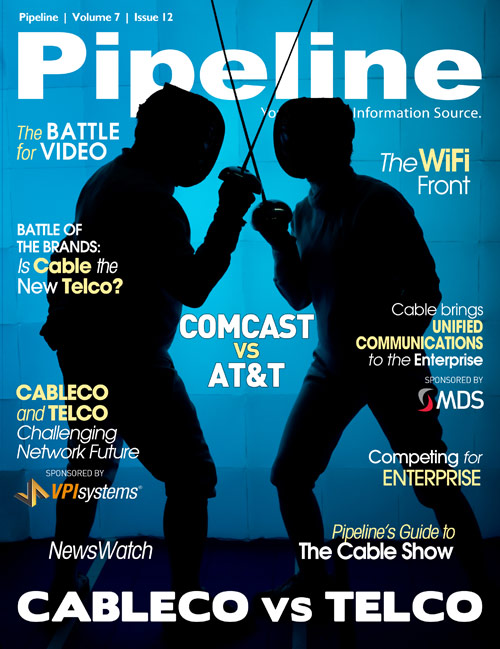Telco v Cable in Fixed Wireless
It's also very difficult to tell which locations are free. Verizon's web site insists that its WiFi hotpots are only open to Verizon customers with certain Internet or wireless data plans. But a quick call to some of the businesses listed in the hotspot finder, like Hop Haus Chicago, a popular spot for craft beers and burgers, reveals that some hotspots are free for anyone.
On the subscription mobility front, Verizon has enabled a mobile tablet and smartphone app for its FiOS subscribers but the service isn't advertised as offering a whole lot of perks. Subscribers can pay to view content on-demand on their mobile devices, and can remotely program their DVRs, but the strategy doesn't exude openness. On April 21, a Reuters report quoted Verizon CFO Fran Shammo saying that the company is focused on its negotiations with content producers "to put our content on mobile devices."
Such ongoing negotiations would explain the current vagaries in Verizon's FiOS mobile offering. Ortiz argues that "the content providers are well advised to be very concerned about any redistribution of their content," especially given the tough lessons learned in the music industry. For big entertainment producers, their easily distributed and pirated content is "what they produce, what they own" says Ortiz, "it's their value proposition."
Cablevision Leads Early, Fades Late
Cablevision is included in this contest because of its presence in the largest city in the United States – New York – and because early in the WiFi game, the operator promoted its WiFi strategy aggressively. Cablevision helped drive the concept of subscription mobility into the cable market, though initially it was focused on "free" access to WiFi hotspots when, a few years ago, free WiFi – as opposed to pay-per - wasn't as easy to find as it is now.
Cablevision has no footprint in Chicago, Peoria, or Dayton simply because these cities are not part of its service territory. But its WiFi footprint in its prime geography – in and around New York City – is an odd patchwork. There are at least 335 hotpots in Brooklyn, 278 in the Bronx, and more than 150 in metro New Jersey along the Hudson. But the operator has almost no WiFi presence in the borough of Queens. Its hotspots in Manhattan are limited to a handful, though they cover Madison Square Garden, which Cablevision owns, and Penn Station (the major train station serving the west side of Manhattan, located underneath Madison Square Garden); the 79th Street boat basin; Radio City Music Hall, which Cablevision also owns; as well as a smattering of sites in lower Manhattan.
As with Verizon, there just doesn't appear to be a strategic approach to Cablevision's Optimum WiFi offering. There are no consistent, big brand locations outside of properties Cablevision owns. There are huge holes in its coverage area. And in the bigger picture, its footprint is essentially dwarfed by AT&T's.
Until and unless Cablevision delivers on some real subscription mobility promises, it's hard to call its WiFi strategy a winner, despite its early adoption of the concept. And on that front, Cablevision appears to be trailing the pack. It offers remote DVR programming, but that's about it. Cablevision is interesting because it's a conundrum; it lead the way in public WiFi, but its execution was patchy. It was early to deliver mobile DVR programming, but hasn't followed with a strong mobile content play. Given its presence in one of the largest media, fashion, and finance markets in the world – New York City – this disconnect doesn't make much sense. But then again, die-hard fans of the New York Knicks who've suffered through a decade of embarassment know Cablevision's management skills all too well.
What's Missing, and How BSS Can Help
A major element that's missing from the WiFi value proposition is a contextual offer and the point of eyeball capture. In other words, there are a few seconds or so where a user needs to accept a terms of use policy on a redirect web page in order to access even free WiFi. At McDonalds, you accept the terms of use on a red page with the golden arches, and then are free to go to your web page. But those few precious seconds aren't even used to sell you some dessert. At Starbucks, you land on a Starbucks web page that says something about accessing Starbucks digital content, but there's no link to it and no way to get back to the page once you leave it. That's a missed opportunity.
There does not appear to be a whole lot discussion within service providers today in regards to monetizing that eyeball capture moment. "We've seen, as we've talked to our clients, more of a push towards managed spending and balance management," says Brian Clark, Executive Director of Product Management for CSG Systems. Operators want to make sure customers have spending control as they upsell and offer more pay-per content. At the same time, says Ortiz, "real time mediation and policy control is emerging" in order to provide "better means to manage and control the policies" related to value-added services.
With such controls in place, the missing piece is personalization, but that's soon to emerge as well. "Analytics is definitely a focus of our clients," says Clark. "We are taking data about subscribers and providing that to different channels a subscriber might access," Clark says, "and we are integrating those analytics into the channels so we can provide personalization." This is where the loop needs to be closed in WiFi. Its 9 pm, my toddler is sleeping, and I've snuck out for coffee and some quiet time. I've got my iPad. I connect to WiFi at the café and it offers me a crossword puzzle, a first person shooter game, and the latest episode of Deadliest Catch, or all three for $5. Sold; moment of eyeball capture monetized.




